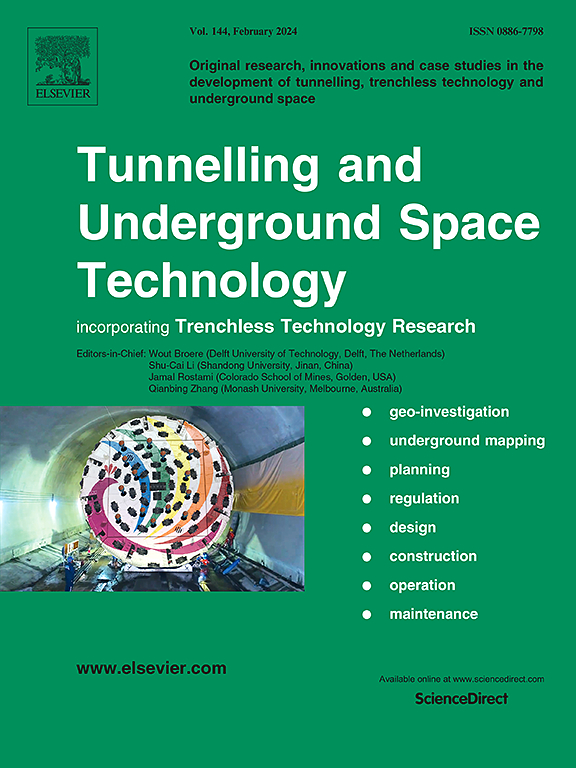堵塞比和点火位置对圆截面隧道正丁醇火焰蔓延非定常性能的影响
IF 7.4
1区 工程技术
Q1 CONSTRUCTION & BUILDING TECHNOLOGY
引用次数: 0
摘要
采用圆形截面盾构隧道,可以在不破坏围岩和地面建筑物的情况下施工。圆形断面隧道车辆碰撞事故引起的漏油事故是引起油料火灾的主要原因。隧道顶棚和侧墙的结构强度应在火灾作用下显著降低。此外,一旦隧道发生火灾,常用的处理方法是堵住横断面弯曲隧道的一个或两个入口,隔离氧气,使火灾自熄。本文研究了两种截面弯曲隧道中正丁醇燃料的火焰传播特性,其中堵塞率为2% ~ 100%,曲率半径分别为50和100 mm。堵料比为堵料片密封的圆弧面积与圆形隧道截面积之比。在三种封堵方式(点火端封堵、不点火端封堵和两端封堵)下进行了火焰蔓延试验。试验在5和10毫米两种燃料深度下进行,这代表了火焰蔓延的薄池和厚池。总结了三种封堵方法下火焰蔓延的现象和分类。当堵塞率从10%增加到50%时,脉动区火焰传播频率从2.5 Hz增加到4.5 Hz。随着两端堵塞比的增大,分离时火焰前缘位置从β = 2%时的906 mm减小到β = 50%时的542 mm,火焰分离位置从β = 2%时的348 mm减小到β = 50%时的65 mm。火焰分离位置向点火端移动,说明两端堵塞能有效抑制夹带氧气,从而减小截面弯曲隧道内的燃烧面积。在火焰穿梭阶段,瞬时火焰传播速率大于10 cm/s,属于气相控制状态。这是因为火焰穿梭时的液体温度大于正丁醇的闪点(38℃)。在稳定蔓延阶段,火焰蔓延属于液相控制状态,点火端堵塞时,火焰蔓延速率随堵塞率的增加而略有增加,而非点火端堵塞和两端堵塞时,火焰蔓延速率明显降低。这表明,在圆形断面隧道的真实火灾现场,建议加大封堵比,采用两端封堵的方法扑灭液体火灾。这与不同封堵比和封堵方式下火焰脉动频率的研究结果一致。本文章由计算机程序翻译,如有差异,请以英文原文为准。
Influence of plugging ratio and ignition position on unsteady performance of flame spread over n-butanol in circular cross section tunnels
The shield tunnel with the circular cross section can be built without destroying the surrounding rock and ground buildings. Oil fires are particularly dangerous commonly existing from oil leaks caused by vehicle collision accident in circular cross section tunnel. The structural strength of tunnel’s ceiling and side walls should be significantly reduced by the fire. In addition, once a tunnel fire occurs, a common disposal method is to block one or two entrances of the cross-sectional bending tunnel, isolate the oxygen and make the fire self-extinguishing. In this work, the performances of flame spread over n-butanol fuel in two cross-sectional bending tunnels are revealed with the plugging ratios in range of 2 %−100 % and the curvature radius of 50 and 100 mm respectively. The plugging ratio is labeled as the ratio of the arc area sealed by the blocking sheet to the cross-sectional area of circular tunnel. The flame spread tests were conducted under three plugging methods (ignition-end plugging, non-ignition-end plugging and two-ends plugging). The tests are conducted under two fuel depths of 5 and 10 mm, which represent thin and thick pools of flame spread. The phenomena and classifications of flame spreading under the three plugging methods are summarized. The frequency of flame spread in pulsation regime increases from 2.5 to 4.5 Hz as the plugging ratio increases from 10 % to 50 %. With an increase in plugging ratio for two-ends plugging, the flame front position at the separation time decreases from 906 mm at β = 2 % to 542 mm at β = 50 %, and the flame separation position decreases from 348 mm at β = 2 % to 65 mm at β = 50 %. The flame separation position moves to the ignition end, indicating that the two-ends plugging can effectively inhibit oxygen entrainment, thereby reducing the burning area in the cross-sectional bending tunnel. In flame shuttling stage, the instantaneous flame spread rate is larger than 10 cm/s, so it belongs to the gas-phase controlling regime. This is because the liquid temperature during flame shuttling is larger than the flashpoint of n-butanol (38 °C). In stable spreading stage, the flame spread belongs to liquid-phase controlling regime and the flame spread rate is slightly increased by plugging ratio for ignition-end plugging, but decreased considerably for non-ignition-end plugging and two-ends plugging. This indicates that in a real fire scene in a circular cross section tunnel, it is recommended to increase the plugging ratio and use the two-ends plugging method to put out the liquid fire. This is consistent with the findings of the flame pulsation frequencies under varied plugging ratios and plugging methods.
求助全文
通过发布文献求助,成功后即可免费获取论文全文。
去求助
来源期刊

Tunnelling and Underground Space Technology
工程技术-工程:土木
CiteScore
11.90
自引率
18.80%
发文量
454
审稿时长
10.8 months
期刊介绍:
Tunnelling and Underground Space Technology is an international journal which publishes authoritative articles encompassing the development of innovative uses of underground space and the results of high quality research into improved, more cost-effective techniques for the planning, geo-investigation, design, construction, operation and maintenance of underground and earth-sheltered structures. The journal provides an effective vehicle for the improved worldwide exchange of information on developments in underground technology - and the experience gained from its use - and is strongly committed to publishing papers on the interdisciplinary aspects of creating, planning, and regulating underground space.
 求助内容:
求助内容: 应助结果提醒方式:
应助结果提醒方式:


